It can be so tempting to get caught up in the latest and supposedly greatest firearms on the market.
They’re shiny and new, and come with so many promises of amazing firepower and shooting experiences like you’ve never experienced before. Sometimes it’s hard to remember that new isn’t the end all to be all when it comes to getting a great gun or a great experience.
The following firearms are examples of just that.
These are guns that helped the Allies win the Second World War, but are still in high demand today. Many of them are still in military service even now.
Whether you’re a historical weapon collector or just want a break from the brand new, these are the firearms for you.
Table of Contents
Loading…
1. Mosin-Nagant
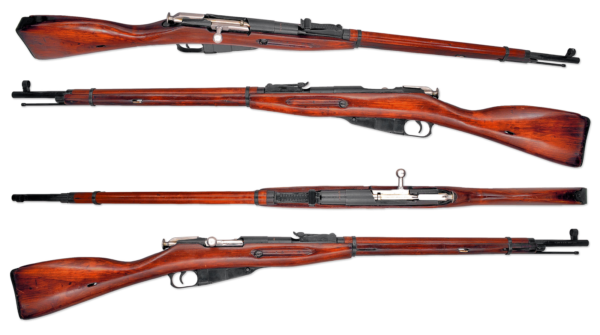
The Mosin-Nagant, officially designated the 3-line rifle M1891, is the longest serving military bolt action rifle still in official service today, entering service way back in 1891.
This Russian manufactured Mosin-Nagant has been involved in a steady stream of conflict from the Russo-Japanese War, through both World Wars, all the way up to the Syrian Civil War and the current Russian conflict with Ukraine.
All that is to say that this rifle has seen some shit.
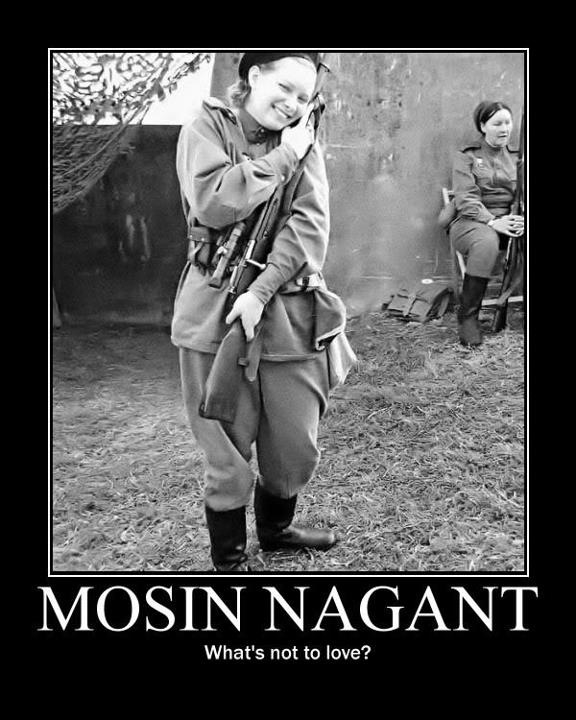
But this article is about World War II, so let’s talk about that.
The Mosin-Nagant was the standard issue rifle of the Soviet Union, who had the largest mobilized army in history. It was particularly favored on the urban battles on the Eastern Front and played a significant role in the Battle of Stalingrad (now the city of Volgograd). This was the rifle that was used by historic Soviet snipers like Vasily Zaytsev and Ivan Sidorenko.
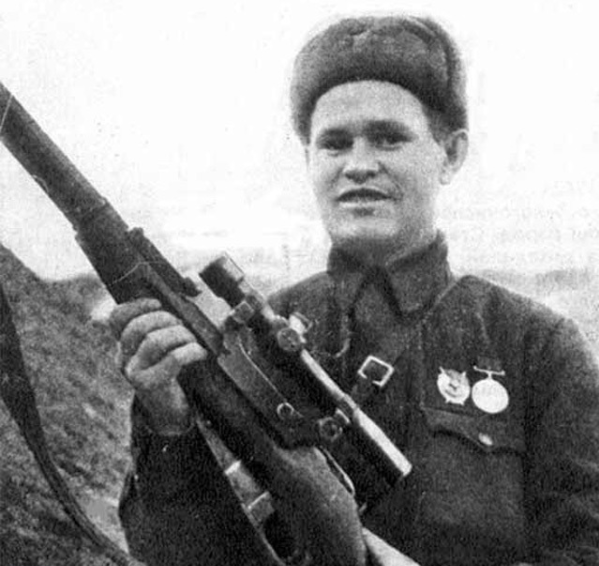
Finland had its own model of the Mosin-Nagant, which they also issued to their snipers. Simo Häyhä, generally considered the deadliest sniper in history, is responsible for the deaths of 505 Soviet soldiers, many of which were killed using his Finnish M/28-30 Mosin–Nagant rifle.
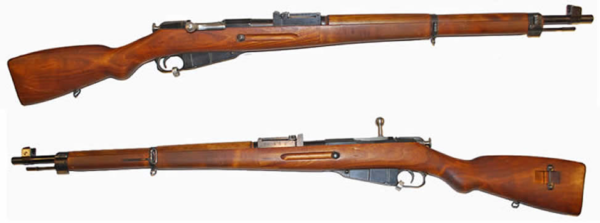
The reasons that the Mosin-Nagant was so favored during World War II are not dissimilar from the reasons it’s favored by both militaries and civilian hunters today. It’s not a pretty gun. In fact, war time models can be identified by tool marks and rough finishes which were a result of the need to quickly mass produce the rifle.
However, what it lacks in aesthetics it makes up in practicality (a very Russian way to design a gun, no?) The Mosin-Nagant is considered to be one of the most reliable and easy to maintain rifles in military history, especially when compared to other rifles at the time.
The Mosin-Nagant ceased production in 1965, but surplus rifles are still used by about 30 militaries today. The Mosin-Nagant is also a favorite of historical gun collectors, hunters, and hobby shooters.
Fortunately for you, the Mosin-Nagant is one of the most mass-produced firearms in history, with roughly 37 million made in Russia alone (so not counting any that were American or Chinese produced, which do also exist).
This means that surplus Mosin-Nagants are easy to find, especially since the fall of the Iron Curtain and the rise of internet gun sales. Depending on condition and accessories, Mosin-Nagants can be found for as little as $200 to as much as $1,500, though most go for between $300 and $600.
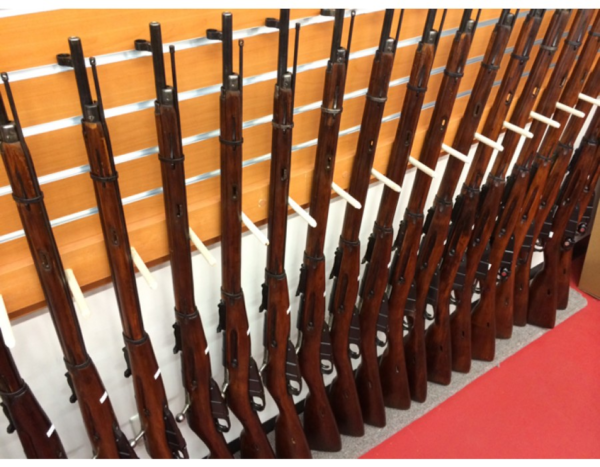
2. Lee-Enfield
The British Lee-Enfield rifle takes second place to the Mosin-Nagant for longest serving military bolt action rifle still in service. It was the standard issue rifle of the British Army and the armies of other Commonwealth countries during both World Wars.
While the Mosin-Nagant was primarily used on the Eastern Front, the Lee-Enfield was used around the globe, particularly in the North African, Italian, and Pacific theatres.
Obviously, the Lee-Enfield was used by the British Army and Commonwealth forces from countries like Australia, Canada, India, New Zealand, and South Africa. Other Lee-Enfield users during World War II include Greece and Denmark, as well as French and Czechoslovak Resistance forces.
Captured Lee-Enfields were even highly coveted by Axis troops from Germany and Italy because of the rifle’s reputation for reliability, speed, and accuracy thanks to a smooth action and advanced adjustable sights.
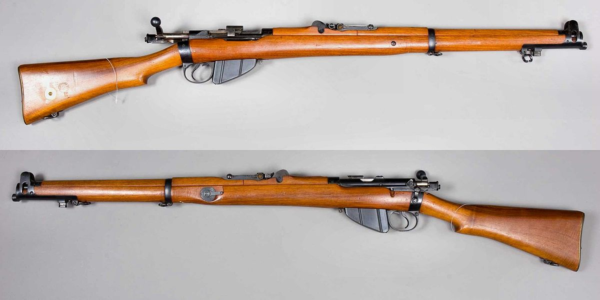
That reputation has persevered to this day. Because of the Lee-Enfield’s accuracy, reliability, capacity, power, and outstanding rate of fire, the Military Channel placed it third on their list of best combat rifles ever designed. The rifle has also been given the nickname “the Cadillac of bolt-action rifles” because of its speed, reliability, and accuracy.
Despite its excellent reputation, technology eventually caught up with it and the Lee-Enfield was no longer in widespread use by the British Army by the 1960s, but continues to be used by other Commonwealth militaries and police forces today, most notably in Bangladesh.
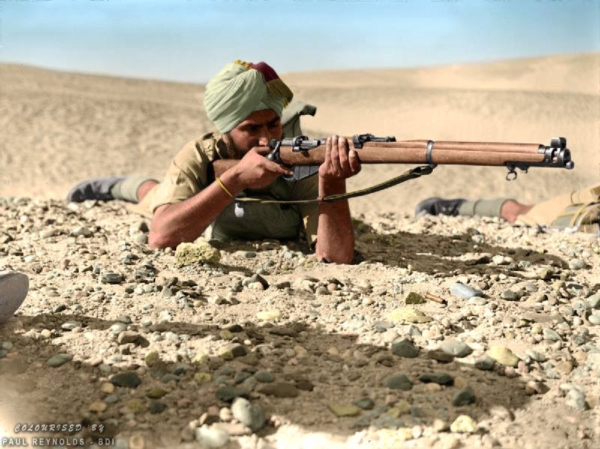
The Lee-Enfield was not produced in nearly the same numbers as the Mosin-Nagant, but it is estimated that over 17 million Lee-Enfield rifles of various models and conversions were produced before the gun ceased production in 1953. That’s no small number, leaving plenty of Lee-Enfields still on the second-hand firearms market today.
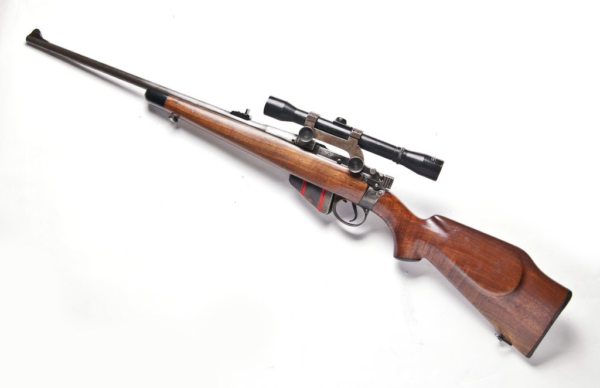
Later models like the No 4 MkI, used during World War II, are particularly easy to find. A Lee-Enfield No4 MkI in good condition sells for between $300 and $400. Older models in excellent condition go for more, but unless you’re a collector of historical firearms, there’s no reason to spring for those.
3. M1 Garand
The American M1 Garand, made by Springfield Armory, is one of the younger firearms on this list. The rifle entered service in 1936, just five years before the attack on Pearl Harbor and the United State’s entry into World War II.
The M1 Garand was the standard United States service rifle during World War II, used by all branches of the military. American military leadership was overwhelmingly impressed with the M1. Historic General George S. Patton even described the M1 Garand as, “the greatest implement of battle ever devised.“
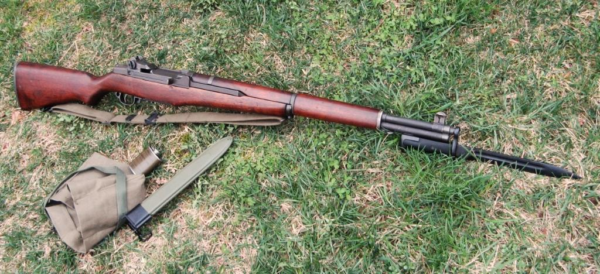
Prior to World War II, even the British Army considered the M1 Garand as a replacement for the Lee-Enfield but weren’t convinced that the M1 was able to withstand the mud of the trench style of warfare they experienced in World War I, as well as the Lee-Enfield, could.
The primary tactical advantage of the M1 Garand was that the semi-automatic rifle allowed American troops to fire eight rounds before having to stop and fumble with the bolt action design that was standard for service rifles at the time.
Comparatively, the German standard issue service rifle, the Karabiner 98K (which, incidentally, is also still in service, though it is not discussed on this list) could only fire off five rounds. The Italian Carcano M1891 could fire six.
All in all, around 5.4 million M1 Garands were produced, hundreds of thousands of which were given to American allies as foreign aid, both during and after the Second World War.
The M1 Garand is still in use by various militaries but is more widely known for its current use by insurgent groups including those in Iraq and Afghanistan, as well as the IRA, the Syrian National Coalition, and the Moro National Liberation Front in the Philippines. It is also a common rifle choice for use by military drill teams and ROTCs, perhaps most notably by the US Marine Corps Silent Drill Team.
Originals can be found, but they aren’t as widely available for civilians to purchase as the Mosin-Nagant or Lee-Enfield rifles.
The Civilian Marksmanship Program is a great way to get your hands on an original M1 Garand for a reasonable amount of money. However, they restock at the beginning of the year and sell out quickly, especially when it comes to the less expensive models, so you’ll want to buy early. Depending on condition and model, the Civilian Marksmanship Program’s M1 Garands sell for between a couple hundred and a couple thousand dollars.
For those who want a more contemporary option, the MK14 ($3,700) is the way to go.

The MK14 is the M1’s modern counterpart. One could really call the MK14 the grandchild of the M1, as it was designed to replace the M14 as the US Army’s standard issue service rifle, which was in turn designed to replace the M1.
What’s your take on the M1?
4. Browning Hi-Power
Next comes the first pistol on our list, the Browning Hi-Power. While the HP bears his name, gun designer John Browning actually died in 1926, several years before the HP’s design was finalized in 1935, and it had to be completed by Dieudonné Saive at the Belgian firearm company FN.
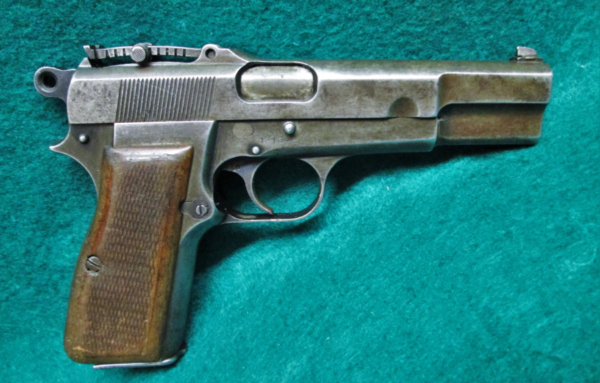
The HP was designed starting in 1914 in response to a request by the French Army for a new service pistol, but it became one of the most widely used military pistols in history. In a bit of a historical anomaly, the Browning Hi-Power was actually used by both the Allies and the Axis in World War II.
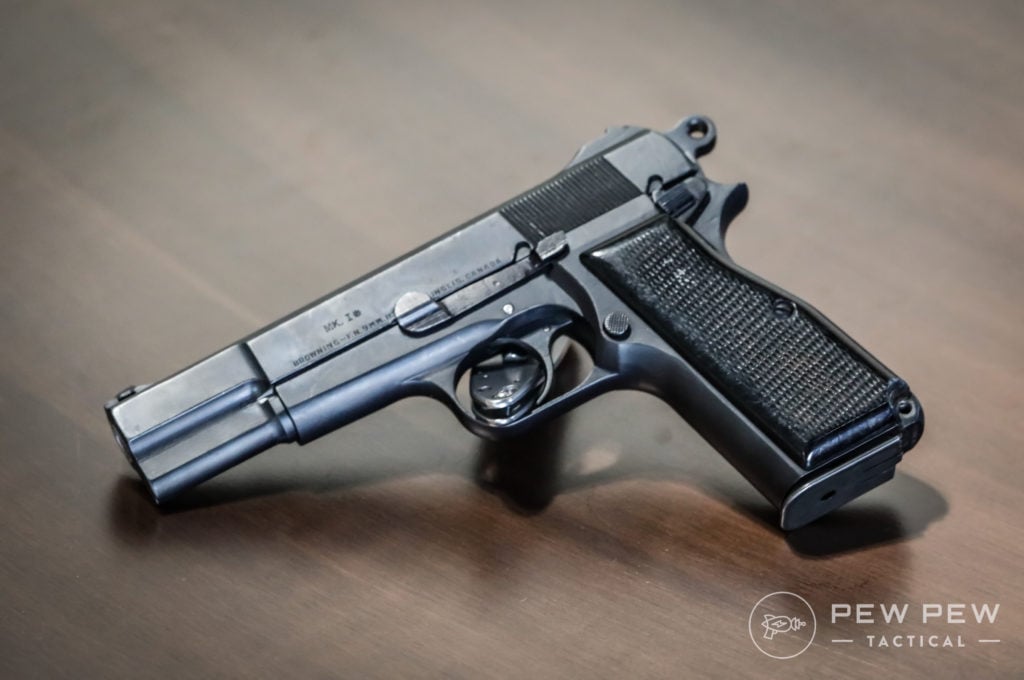
After German forces began occupying Belgium in 1940, they took over an FN factory and began producing HPs of their own. These pistols can be identified by the German inspection and service marks that they bear, also called Waffenamts after the German weapons agency. They were primarily distributed to Nazi military police and paratroopers.
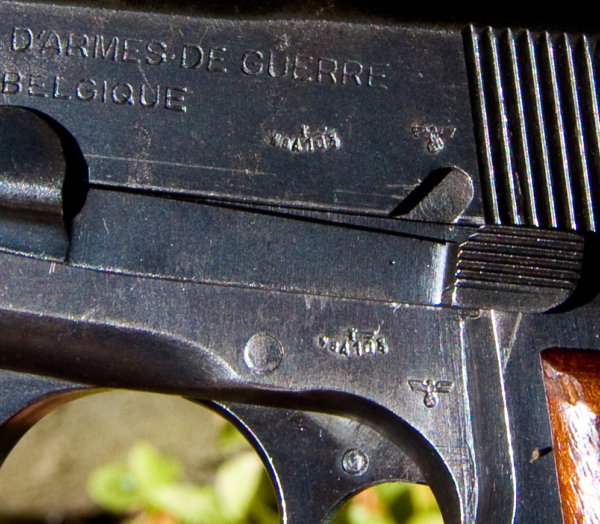
The Hi-Power was also manufactured in Canada by John Inglis and Company and by FN in Britain for use by the Allied forces. Among the Allies, the Hi-Power was most commonly used by British airborne forces, especially the Special Air Service, and the Special Operations Executive, a British covert operations organization, as well as the US Office of Strategic Services.
The Browning Hi-Power’s primary advantage is alluded to in the pistol’s name. The HP has a 13 round capacity, almost twice that of the Colt M1911 (discussed next on this list) or the German Luger. These shots were made particularly meaningful by the relatively large caliber of the ammunition. The Hi-Power was manufactured in 9mm and .40 S&W calibers.
You might think that this would lead to a heavy pistol, but one of the French Army’s design requirements was that the firearm be compact, and Browning and FN certainly accomplished this, producing a pistol that weighs only 2.2 lbs.
That’s not to say this is a perfectly comfortable gun to shoot. The Hi-Power has a heavy trigger pull due to its magazine disconnect safety. The pistol also has a tendency towards hammer bite, though this is more common with commercial models than military ones.
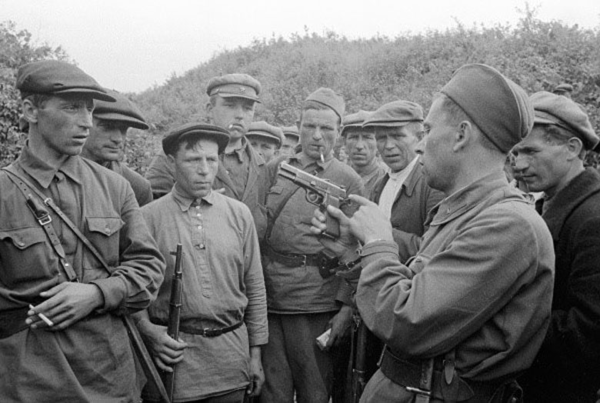
The HP is to this day the standard sidearm of the Belgian Army, Indian Army, Indonesian Armed Forces, Australian Defence Force, Argentine Army, Luxembourg Army, Israeli Police, Venezuelan Army, and more. However, the Hi-Power has become less widely used since the 90s as militaries and police forces have dropped it in favor of newer designs, like the SIG Sauer P225 and P226, and various Glock 17 models.
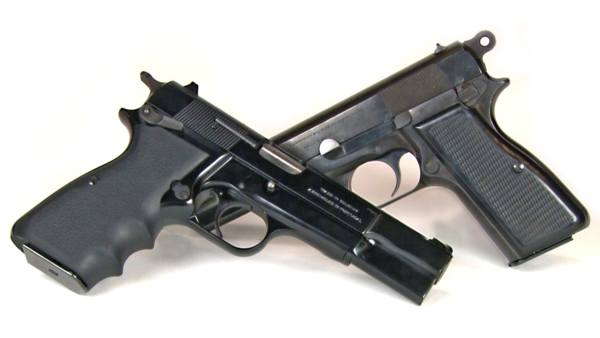
The Hi-Power is still in production by seven different companies around the world, though (FN Herstal, Norinco, Fegyver- és Gépgyár, the Ishapore Rifle Factory, Pindad and KSN Industries), so it’s easy enough for you to get your hands on, particularly the modern Browning Hi Power Mark III ($920).
5. Colt M1911
The Colt M1911 is another Browning designed pistol and another WWII era firearm that continues to be manufactured to this day.
The M1911 was the United States Armed Forces’ standard issue sidearm from 1911 to 1986, when it was replaced by the 9mm Beretta M9. However, modern variants of the M1911 are still in use by units in the US Special Forces, US Navy, and US Marines.
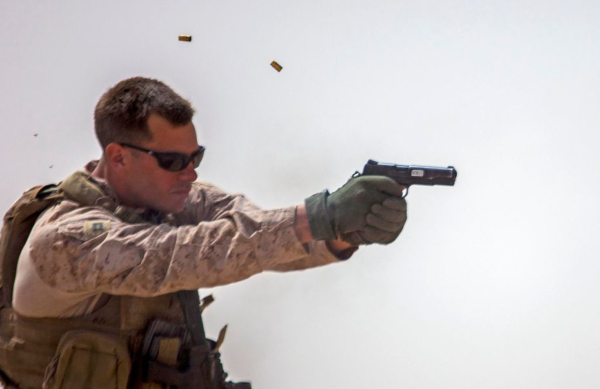
The pistol has seen every US military conflict since World War I, including Desert Storm and Operations Iraqi and Enduring Freedom. This makes it the longest-serving firearm in US military history.
The Colt M1911 was not just used by the American military in World War II, however.
British commando units and the Special Operations Executive favored the M1911, as did British South African forces. In addition, the Royal Air Force issued M1911s, which had been previously used by the Royal Navy in World War I, as sidearms for air personnel in the event that they crashed or had to bail behind enemy lines.
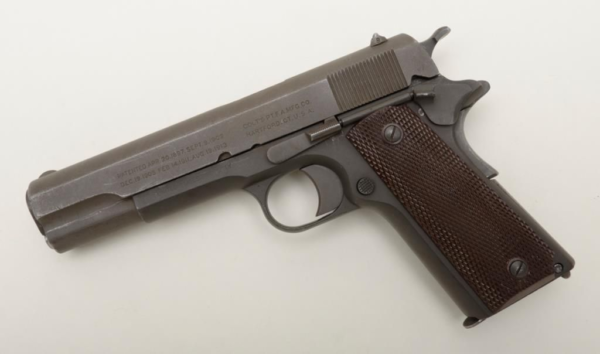
Canadian officers were allowed the option of privately purchasing a sidearm of their choice, and commonly selected the M1911. In addition, the Canadian-US First Special Service Force used the M1911, among other American infantry weapons.
On the other side, like the Lee-Enfield rifle, captured M1911s were highly prized and coveted by German troops.
These days, the Colt M1911 is used by the Marine Corps Special Operations Command, Los Angeles Police Department SWAT and SIS., the FBI Hostage Rescue Team, FBI regional SWAT teams, and 1st Special Forces Operational Detachment-Delta (Delta Force), as well as various international military and police units.
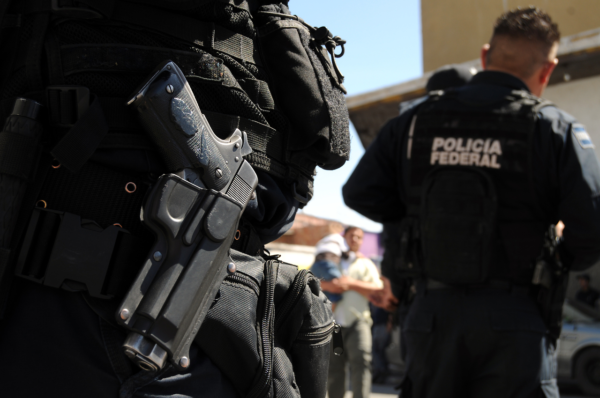
The firearm’s outstanding reputation for durability and reliability makes it excellent for these purposes. Despite the competition from advancing firearms technology, the M1911 has managed to continue to remain remarkably popular.
As for civilian use, the M1911 is particularly popular among competitive shooters, who use them for various events including USPSA, IDPA, International Practical Shooting Confederation, and Bullseye shooting, despite the fact that the M1911 is heavier than other modern favorites.
The design of the M1911 has changed very little over the course of its production, so even a brand new M1911 feels incredibly similar to shooting an early model.
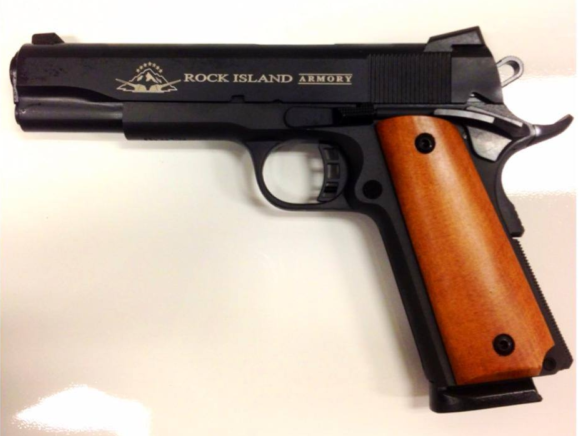
For the closest match, go with the Rock Island manufactured version ($700), which is chambered for .45 ACP just like the original.
And check out our list of the Best 1911s for our picks from affordable to best-bang-for-the-buck and even astronomical.
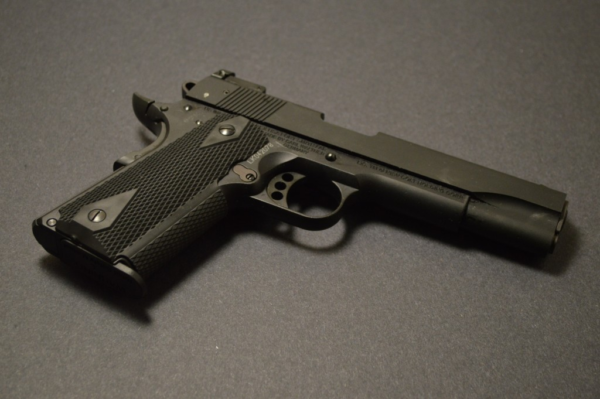
Of course, you can also go for an older model, but there are far fewer of these than other guns on this list floating around. This is both because government use of this firearm has continued, and because fewer were made in the first place.
1.9 million units were contracted by the US government during the Second World War, produced by several different companies, including Remington Rand (900,000 produced), Colt (400,000), Ithaca Gun Company (400,000), Union Switch & Signal (50,000), and Singer (500). Singer models in particular command a high price from historical firearms collectors, regardless of condition.
6. M2 Browning Machine Gun
The M2 Browning comes behind only the Colt M1911 for the title of the longest-serving firearm in American history, and it’s still in use today. Like the M1911, the M2 has seen every US military conflict since World War II, from the Western Front to Afghanistan and Iraq.
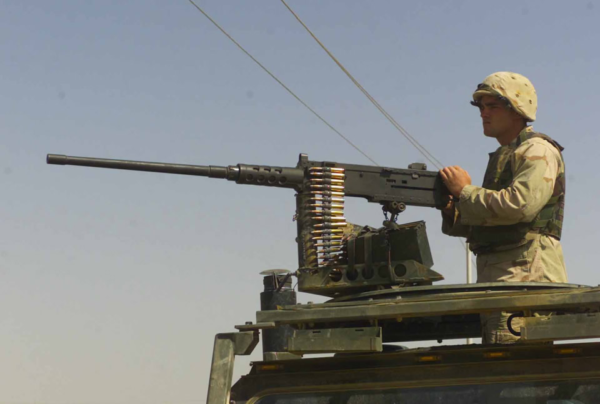
However, the M2 is on a completely different level of military firepower from the other firearms on this list, and it’s amazing to see.
While those other guns were sidearms, the M2 machine gun goes beyond even just artillery. During World War II, American, British, and Commonwealth forces used the M2 as fixed aircraft guns, anti-aircraft guns on aircraft, ships, and boats, infantry guns using tripod mounts, and as anti-aircraft/anti-vehicular guns mounted on vehicles.
M2s might have been used individually or in groups of up to eight guns. A single M2 had a rate of fire of about 800 12.7×99mm NATO rounds per minute. A unit operating eight? That’s 6400 rounds per minute.
The M2 was particularly effective when used as a vehicle mount against German forces. It could easily damage the hull or fuel tanks of armored cars and take out the engine block or fuel tank of a low altitude Bf 109 fighter.
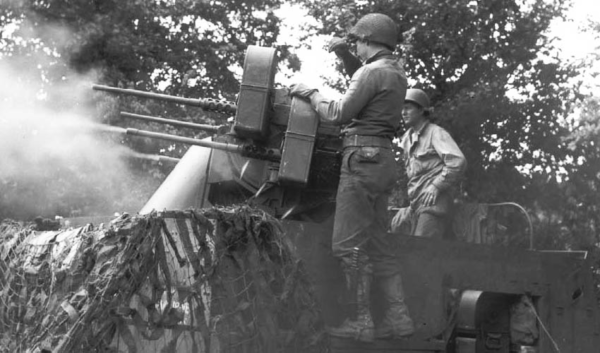
Another effective strategy was to mount the gun on a sandbagged tripod either as a defensive weapon or to block or intercept road intersections from use by German infantry and vehicles. This latter method struck particular fear into the hearts of German troops. Just the sound of an M2 firing was often enough to get enemy troops to cease combat and take cover.
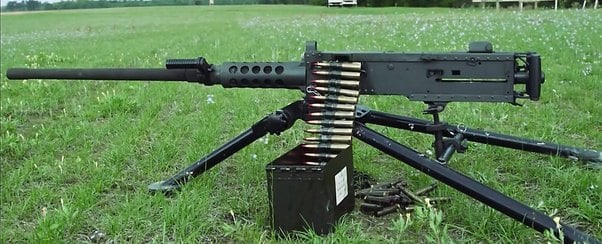
However, this incredible machine was not widely used in the Pacific Theatre, though use was not entirely unheard of. The M2 weighs 83.78 lbs (127.87 with the tripod) and has a total length of just over 65”. This massive size made it impractical for jungle combat.
The M2 machine gun is easily the most difficult firearm on this list for a civilian to get their hands on, but it is possible.
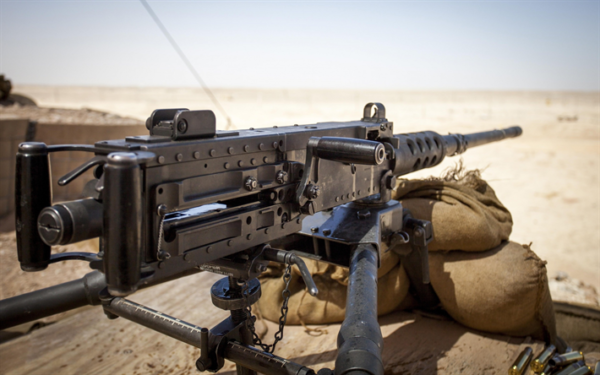
You can buy an M2 for your own use as long as:
- You are over 21 years of age;
- The gun was manufactured before May 19, 1986;
- The transfer is registered with the ATF;
- You pay the $200 dollar tax for purchase;
- You don’t import the gun or take it across state lines without a federal permit;
- The gun has the legally required identification marks (including serial number, manufacturer, and any other legal requirements);
- The purchase and firearm comply with state and local laws; and
- You are willing to pay tens or even hundreds of thousands of dollars for the M2 itself. (That $200 dollar tax doesn’t seem so pricey in comparison now, does it?)
So basically what I’m saying is you can get one if you have plenty of money to burn and the time and energy to jump through the legal hoops to obtain military grade firepower. Seems to make the 21 and older age restriction a bit redundant, doesn’t it?
Go Forth and Collect
If you’ve read much of my writing here at Pew Pew Tactical, you may have noticed that I kind of have a thing for historical firearms, and the guns on this list are no exception.
There’s something special about a piece of machinery that has such an excellent design that it continues to be used almost eight decades later (or more for some of these firearms), even in the face of constant technological improvements. In a world where so many things are quickly dropped so that we can adopt the newest version, it’s reassuring, in a way, to be reminded that the classics still have value.
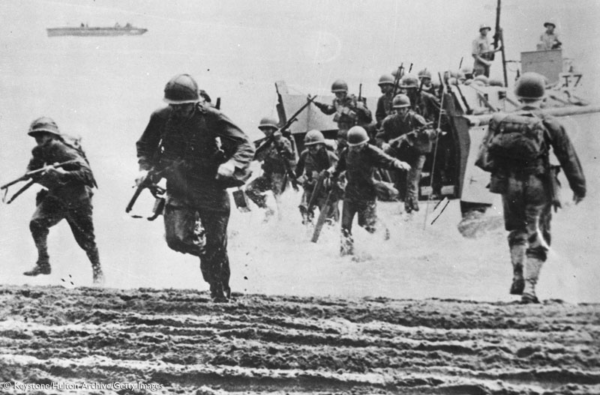
Now, as always, I want to hear what you think.
What are your favorite World War II firearms, whether you can still get them or not? Do you have any of the firearms on this list? Or to go more back in time…check out our Most Famous Guns of WW1.

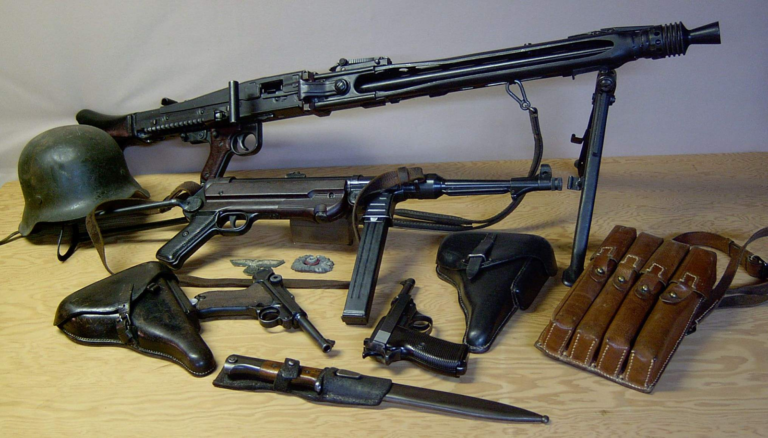
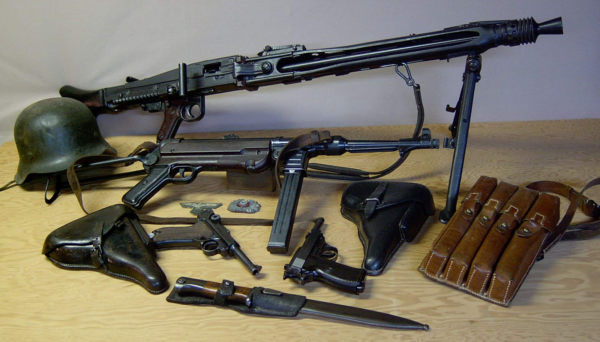




18 Leave a Reply
Love this article. I am a collector of only former military weapons. Living in Canada these days I am limited to rifles that aren't on the prohibited list. I have all of the rifles mentioned. The Lee-Enfield is a lot of fun to shoot especially with a small scope. Great range.
M1 carbine. Light, compact and easy recoil. Granted it was to be used by troops who normally would be issued a rifle, but their duty precludes that issue.
Lee Enfield no4 mk1., better sights and a good rate of fire for a bolt.
Thank you for taking the time to write this article, I agree with your list for the most part. The only thing I would add to complete the list is the short lived M14. M1A as us citizens would call it. There still made today by Springfield Armory in a semi-auto only version. The U.S. Military tried a full auto rifle but was hard to hang on to with accuracy, even with its weight. Today's rifles are made to be used on the competition range like NRA Highpower or CMP matches. Chambered in 308 Winchester among other cartridges and has a box magazine of 5 to 20 cartridges. The M14 can take most game in North America, though mounting a scope on an M14 is really weird to me but can be done, it just needs a little bit to get used to.
The M14 had a very short service (something like 14 years or so) used in Keora and in the beginning of Vietnam and was replaced by the M16. Special Operations units continued to use the M14 up to and past Mogadishu, Somalia. If memory serves me right, it found plenty of use in all the desert battlefields in the middle east. With a dedicated marksman, the M14 has a better ability to cover the wide-open terrain.
The Mosin is on there because Comrade Dog uses it. If Comrade Dog didn't use it, it wouldn't be on the list.
Who buys World War pistols 9 mm german lungar?
Lungar? What's that?
that picture is an m1919 not an m2 machine gun
Good eye, we'll swap that out!
Love the M1911 chambered in .45 ACP. My dad carried one as an officer in the US Navy during WW2. I own one from RIA. I'd love to get my hands on one from WW2 era.
The article posted many facts I was not aware of so I found it most interesting.
I would like to see the M1 Carbine in its various forms added. They are still on the market and as the veterans are dying out some of these rifles are coming up for sell.
Thanks Holston, glad we could help!
The first picture is of German weapons - not Allied.
Other than that, the article is great - I have a 1911 and my father has an M1 and Hi-Power.
I don’t know how you could have excluded the Thompson M1A1 sub-machine gun.
You need to correct your third picture from the bottom, that's a M1919 .30 cal. MG not a M2 .50cal..MG.
I enjoyed the article. To me, the 1911 and M1 are the most iconic, though I MAY be biased! The M2 is my fav!
I think including the caliber bullet that each gun shoots would have been insightful
why was the 30od6 springfield a3-03 not included? Ed
I'd kind of like to see the Browning automatic rifle (BAR) on that list.
Transferable fully automatic versions exist and while they require the same hoop jumping as the M2, they are not quite as pricey to purchase.
If memory serves, there is also a company producing semi-automatic brand new versions today.
I did rent a fully automatic one and found it to be very controllable although I could barely lift it.